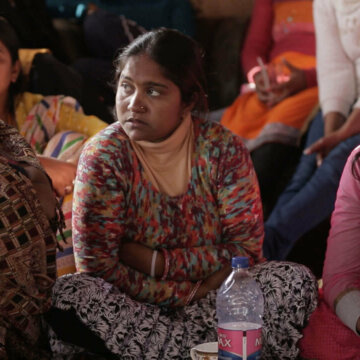- About
- Topics
- Picks
- Audio
- Story
- In-Depth
- Opinion
- News
- Donate
- Signup for our newsletterOur Editors' Best Picks.Send
Read, Debate: Engage.
| topic: | Women's rights |
|---|---|
| located: | India |
| editor: | Tish Sanghera |
In the heart of one of India’s poorest and most populous states a quiet revolution has taken place, reclaiming journalism for some of the most marginalised citizens in the country.
Now a new documentary by Indian directors Rintu Thomas and Sushmit Ghosh has brought the story of Khabar Lahirya, an all-female and all-Dalit (India’s lowest caste) run newsroom to the world.
Titled Writing With Fire, the film is the first from India to be nominated for an Academy Award in the Best Documentary Feature category. It details the inner workings of the women hustling to cover the injustices and lives of those that the mainstream news often forgets.
Widely touted as the festival favourite, the film follows the outlet’s group of ambitious reporters led by their fearless leader Meera. We watch as the women battle not only the challenges of pivoting to digital journalism (when few know how to even use a smartphone), but also a host of complex issues like unsupportive husbands, the prejudices of caste and gender, as well as abusive members of the public.
Located in Uttar Pradesh (U.P), the women work in a state with one of the worst reputations for gender-based caste violence. In 2020, the country was rocked by the gang rape of a 19-year old Dalit girl in U.P’s Hathras village by a group of upper-caste men. The incident shone a light on the prevalence of sexual violence against India’s most oppressed group. It is not an overstatement then to say that these women are putting their lives on the line to dig into stories that typical journalists would not dare cover. The film shows the women bravely seeking out and interviewing survivors of gruesome crimes and organised gang violence, and pursuing officials and asking them why they are not doing more.
The film forces us to reflect on the state of journalism in India - on what it could be, should be and for whom. According to a report by Oxfam India and Newslaundry, Indian newsrooms are dominated by the upper castes, making up 100 percent of all leadership positions in Hindi newsrooms and holding 3 out of 4 anchor roles among Hindi and English language news channels. Affirmative action is the only way to tackle the situation and ensure the country’s media landscape more adequately reflects India’s diversity, said the report. In the aftermath of the Hathras rape, authorities appeared to side with those accused and questioned whether the rape had even occured; the upper-caste dominated media followed suit and tried to erase the link between caste and sexual violence.
Undoubtedly, it is because of these demographics that the film’s images of saree-clad women holding government officials accountable and demanding interviews is so impactful. Indeed, these women are still covering the stories that matter, at a time when many of India’s mainstream newsrooms have diverted resources away from them, or when their privilege blinds them from the nuances.
Image by Writing with Fire

